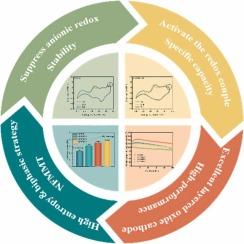高熵策略抑制阴离子氧化还原,提高高性能钠离子电池双相层状氧化物阴极
IF 6.3
2区 材料科学
Q2 CHEMISTRY, PHYSICAL
引用次数: 0
摘要
层状氧化物材料因其高比容量和简单的合成方法而受到广泛关注,但其循环稳定性有待提高。特别是当阴离子参与氧化还原反应时,虽然有可能获得额外的容量增益,但这是以较差的循环稳定性为代价的。为了解决这一问题,提出了一种双相结构调控和高熵策略相结合的方法来抑制阴离子氧化还原,提高循环稳定性。实验结果表明,在100毫安的情况下,使用这种策略可以将阴极材料的比容量从120毫安增加到132毫安,在100次循环后,容量保持率从79.1%上升到90.1%。在10毫安时,比容从133毫安增加到157毫安。测试结果表明,双相结构调节了Na层间距,促进了Na⁺的迁移,减少了晶格损伤,提高了速率能力和循环稳定性。高熵策略通过改变局部电子态来抑制(O₂)n-物种参与氧化还原过程,从而提高循环稳定性,同时激活氧化还原对以提高比容量。本研究提出的双相结构调控和高熵策略的协同应用为开发高性能层状氧化物材料提供了新的前景。本文章由计算机程序翻译,如有差异,请以英文原文为准。

High-entropy strategy suppresses anion redox to boost high-performance biphasic layered oxide cathodes for sodium-ion batteries
Layered oxide materials garner extensive attention owing to their high specific capacity and straightforward synthesis, yet their cycling stability requires improvement. Particularly when anions participate in redox reactions, although additional capacity gains are possible, this occurs at the expense of poor cycling stability. To address this issue, a combined approach of biphasic structure regulation and a high-entropy strategy is proposed to suppress anion redox and enhance cycling stability. Experimental results demonstrate that applying this strategy increased the specific capacity of the cathode material from 120 to 132 mAh g⁻¹ at 100 mA g⁻¹ , with capacity retention rising from 79.1 % to 90.1 % after 100 cycles. At 10 mA g⁻¹ , the specific capacity increased from 133 to 157 mAh g⁻¹ . Testing results indicate that biphasic structure regulation modulates the Na-layer spacing, facilitates Na⁺ migration, reduces lattice damage, and enhances rate capability and cycling stability. The high-entropy strategy suppresses the participation of (O₂)n- species in redox processes by altering local electronic states, thereby improving cycling stability while activating redox couples to enhance specific capacity. The synergistic application of biphasic structure regulation and high-entropy strategy proposed in this study offers novel perspectives for developing high-performance layered oxide materials.
求助全文
通过发布文献求助,成功后即可免费获取论文全文。
去求助
来源期刊

Journal of Alloys and Compounds
工程技术-材料科学:综合
CiteScore
11.10
自引率
14.50%
发文量
5146
审稿时长
67 days
期刊介绍:
The Journal of Alloys and Compounds is intended to serve as an international medium for the publication of work on solid materials comprising compounds as well as alloys. Its great strength lies in the diversity of discipline which it encompasses, drawing together results from materials science, solid-state chemistry and physics.
 求助内容:
求助内容: 应助结果提醒方式:
应助结果提醒方式:


